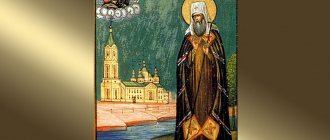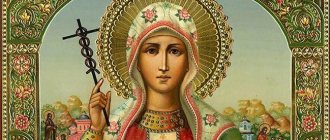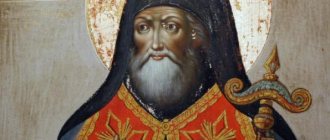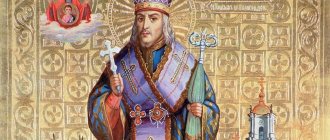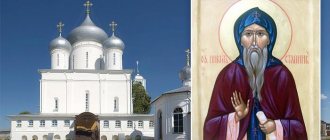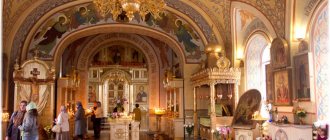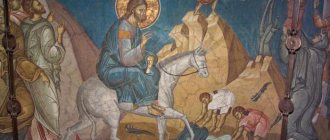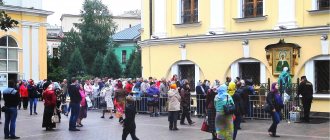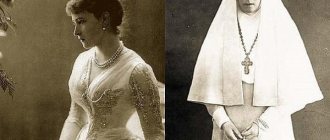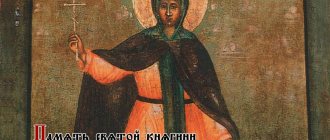| St. Vasily, bishop Ryazansky. Icon. XIX century (RIAMZ) |
Vasily
(+ 1294), Bishop of Ryazan, Saint Commemoration April 12, May 21 - together with the Murom miracle workers of the Blgv. book Constantine and his children Mikhail and Theodore, June 10 - separate [1] and in the Cathedral of Ryazan Saints, July 3, in the Cathedrals of Vladimir and Lipetsk Saints
Information about him is contained in the “Tale of the Ryazan Bishop Vasily”, which exists in two editions: a short, independent one, its author is Ermolai-Erasmus [2], and a revised lengthy one, included in the life of St. book Konstantin of Murom and created in connection with the glorification of the latter at the Council of 1547.
According to the short edition of the Tale, some time after reigning in Murom, St. book Gleb, a bishopric was established, which “not in great times” was occupied by the “righteous bishop” Vasily [3]. He worked tirelessly in God's field: he restored churches, enlightened the ignorant and pagans, and strengthened the weak. The saint was distinguished by remarkable qualities of his soul: gentleness, humility, chastity, vigilance in prayer, abstinence, devotion to God in sorrows.
Not tolerating his good life, the devil, “imagining himself as a girl,” began to publicly appear in the episcopal chambers. Deceived by the devil, the Murom residents expelled Bishop Vasily, who, without anger or irritation, humbly placed his trust in the One who brings down the truth “like the noonday.” He “prayed all night with tears in the cathedral church of Boris and Gleb, performed an all-night vigil, served the liturgy in the morning; from the cathedral he went to the original Church of the Annunciation, there he sang a prayer service before the image of the Mother of God, brought from Kiev to Murom by Saint Constantine, took this icon with him and, with trust in the Mother of God, went to the Oka River to leave both the city and the bishopric forever.”
Arriving on the shore of the Oka, the bishop refused to board the ship, stretched out his mantle onto the water and stepped onto it with the icon of the Mother of God in his hands, after which “he was carried quickly by a stormy spirit ... against the streams” and in less than 6 hours swam to the place “even now Called Old Ryazan.” Here the saint was solemnly met by the Ryazan Grand Duke Oleg Ioannovich. The episcopal see from Murom was moved to Ryazan, where the miraculous icon of the Mother of God, which was with Bishop Vasily, was kept “to this day.”
In the lengthy edition of the Tale, this story is about St. Vasily is unsuccessfully combined with information borrowed from the chronicle about the “renewal” of Murom, Prince. Yuri Yaroslavich in 1351 [4], during which Saint Basil was allegedly installed at the see.
According to chronicles and acts, two Ryazan bishops with the name Vasily are known (the second and fourth, respectively, in the general list of Ryazan bishops). Of these, the first died in 1294 [5]. Vasily II was installed as Metropolitan Alexy in 1356 [6], mentioned in the charter of St. Alexy at Chervleny Yar [7] and died, if we rely on the chronicle order of listing the bishops appointed by St. Alexy, until 1360 [8]. Thus, Prince Yuri Yaroslavich, who was removed from the Murom reign in 1354/55 and soon died in captivity, could not be involved in the installation of Bishop Vasily. However, it was probably not by chance that the compiler of the lengthy edition connected the names of St. Vasily and Prince of Murom. Yuri, because the latter was a contemporary of Vladimir. book Oleg Ioannovich (early 1350s - 1402), mentioned in an earlier short version. In addition, the name “Old Ryazan” used in the short version also refers to the era of the Great. book Oleg, because this name arose after the founding of the “town of Olgova at the mouth of Prone” [9]. It is known that Bishop Vasily II received numerous land grants and benefits in various parts of the Ryazan principality from the great. book Oleg Ioannovich and his son-in-law - Prince Pronsky. Vladimir Dimitrievich [10]. Consequently, the legend reflected in the middle of the 16th century. in the short version of the Tale, probably meant the Ryazan bishop. Basil, who lived in the first half - mid-14th century, although the possibility of correlating St. Vasily with Bishop Vasily at the end of the 13th century. nevertheless, it is impossible due to the confusion and anachronism of the legend (contrary to it, there is no evidence that the episcopal see was located in Murom - from the very foundation at the end of the 12th century, and not at all during the reign of St. Prince Gleb, the see was located in Ryazan).
| Monument at the site of the original burial of St. Vasily Ryazansky. Photo. Beginning of the 20th century Photo from pravenc.ru |
Life of Saint Basil of Ryazan
Saint Basil, as the fourth bishop of Ryazan, is mentioned in the Laurentian Chronicle. Unfortunately, little is known about him: the first description of his life was compiled only in the 16th century by the monk Ermolai, a famous publicist.
It is known that Vasily Ryazansky took monastic vows in Murom, and there, after some time, he was ordained a bishop. According to the biography, Prince Georgy Yaroslavovich took part in this.
After some time, residents accused the bishop of shameful and unworthy behavior: many saw a barefoot and half-naked girl enter his chambers. It was the devil himself, who decided to undermine people's faith in the bishop. Embittered people demanded that Vasily be executed, but he asked to be given until 3 o’clock in the morning.
Vasily Ryazansky spent the whole night in prayer, performed an all-night vigil, served a liturgy and a prayer service before the miraculous icon of the Mother of God. Then at 9 o’clock in the morning he went out to the Oka River and spread the bishop’s robe on the water. Then he stood on the cloth, holding the icon of the Mother of God in his hands, and floated as if on a raft to Old Ryazan, the capital of the principality of the same name. He was in Ryazan already at 3 o’clock in the afternoon, just in time for Vespers, although the distance between the cities is more than 200 km.
A legend has been preserved that the Ryazan priest, officiating the service, could not begin it. He was silent until the Lord enlightened him. The priest predicted that the righteous Bishop Vasily, whom they should honor, would soon come to them.
The department was also moved to the city, and when it was destroyed, it moved to Pereyaslavl Ryazan (modern Ryazan). A perfect miracle was often depicted on icons.
The saint was loved and revered by the laity. His memorial days are June 23 and July 16.
The miraculous appearance of a saint in Ryazan
Tradition says that on that day the residents of Ryazan attended an evening service, the deacon, coming out in the middle of the church, unexpectedly called everyone to the banks of the Oka to meet the bishop. The surprised people appeared near the river just at the moment when the archpastor appeared, standing on a mantle that floated on its own against the current. Joyful exclamations were heard far around, the prince of Ryazan came out to meet the saint with crosses.
Icon of St. Basil of Ryazan
The care of the flock did not last long; as a result of the raids of the Tatars, Ryazan and its churches were burned; in 1288, the saint sailed on his mantle to Pereyaslavl, stopping at the Boris and Glebov Church.
The Church of the Holy Passion-Bearers Princes Boris and Gleb became a cathedral church under the new bishopric, where Father Vasily ruled until 1295.
Meaning and veneration in Orthodoxy
Vasily Ryazansky spent his entire life righteously and peacefully, trying to help people and instruct them on the path of faith. He often talked with parishioners and gave them advice in difficult life situations. Thanks to his kindness, meekness and humility, he enjoyed the love of people both during his life and after death. It is no coincidence that after almost 3 centuries, they did not want to leave his relics outside the walls of the temple, fearing that enemies would abuse them.
Today he is the patron saint of Ryazan, to whom local residents often turn in prayer. He is also considered the patron saint of travelers, especially sailors and those who move on water.
But what he is best known for is the test of faith. Slandered, standing in front of an angry crowd, he did not blindly make excuses and beg for mercy. Believing in the justice of the Lord and his intercession, Vasily boldly stepped on the bishop's mantle and swam, proving his innocence by a perfect miracle.
Iconography
The earliest image of St. Basil of Ryazan is known on the icon “Constantine, Michael and Theodore in the Life” from the Murom church in honor of the Annunciation of the Blessed Virgin Mary, painted in 1714 by the Murom icon painter Alexander Kazantsev (now in the MIHM). 14 of the 87 marks of the icon (from 74 to 87) tell about the saint.
The basis for the independent images of the saint was the miracle of the Murom Icon of the Mother of God included in the plot of the Tale of Vasily of Ryazan, which is connected with the history of the expulsion of the bishop from Murom. The saint is depicted full-length in a three-quarter spread, floating along the river on a mantle spread out on the water, with an icon of the Mother of God in his right hand and with a staff in his left hand (icons: 1918, MIHM; mid-19th century, work by artist N.V. Shumov , RIAMZ; XX century, chapel in the name of St. Basil in the Boris and Gleb Cathedral of Ryazan). In memory of this miracle, which took place through the prayer of the slandered bishop, the icon received a second name - “Prayer of St. Vasily."
The icon shows the 1st floor. XIX century (RIAMZ) Saint Basil is presented against the background of a landscape frontally in full-length, in hierarchal vestments, his hands are spread to the sides - with his right he blesses, in his left the Gospel.
In the “Cathedral of Murom Saints” St. Basil is depicted together with the saints Prince. Constantine and his children Michael and Theodore, Peter and Fevronia, Juliania Lazarevskaya in the 3rd row from the left on the 18th century icon. (MIHM). A cycle of miniatures from the beginning of the century has been preserved. to the Tale of Vasily Ryazansky [12], made on paper of the 17th century. I. G. Blinov and was considered until the end of the 1980s. ancient manuscript [13].
In the summary iconographic original of Filimonov (XVIII century), under April 15, the appearance of the saint is said: “In the likeness of the gray haired braid of Basil of Caesarea, in short, the robe of the saint, crimson, blue underwear, in an omophorion, in the hand is the Gospel, and the other is blessed, on the head is a hat saintly."
A similar description of the image of the saint on April 15 or January 28 is placed in the Stroganov [14], Peretsevsky [15] originals, in a manuscript from the collection. RNB [16] and others.
Location of the relics of St. Basil of Ryazan
After the death of the saint, he was buried in the Ryazan Boris and Gleb Cathedral. At first, his remains were located inside the temple, but due to perestroika, they ended up outside its walls. Local residents did not forget about the saint and took care of his icon. At the beginning of the 17th century, in the midst of troubled times, fearing the destruction of the shrine, Archbishop Theodoret made a lot of efforts to protect it.
The discovery of the incorruptible relics took place on June 20, 1609. They were transferred to the Assumption (Nativity of Christ) Cathedral and placed in the left choir under a bushel. At the same time, the kontakion and troparion were written. In Soviet times, believers saved them from ruin, and in the early 90s they returned them to the temple.
But the miraculous icon that the bishop brought with him disappeared. Only a few copies remained of it, which until recently were also considered lost. In 2002, one was miraculously found, which is located in the Assumption Cathedral in the summer, and in the Nativity of Christ in the winter.
Saint Basil of Ryazan, bishop
Saint Vasily I, the Ryazan miracle worker, is mentioned in the Laurentian Chronicle and is listed fourth in the ancient list of Ryazan rulers. No evidence has been preserved about his origin - from whom, where and when he was born. But indications have been preserved in church hymns that from his infancy Saint Basil was a sanctified servant of the Lord, that from his youth he perfected himself both morally and spiritually, conquering the sinful things in himself through the fear of God and planting everything holy in his soul and heart.
He began his first deeds of piety in Murom. There he took upon himself the holy image of a monk, and when God’s Providence was pleased to make him a hierarch of the Murom-Ryazan flock, he already shone with great feats of abstinence, meekness and humility. About the election of St. Basil to the rank of bishop, his life says this: “After the desolation of the city of Murom from infidel people, the noble prince Georgy Yaroslavich arrived from Kyiv to Murom. This prince renovated the local Church of the Annunciation and the second church of St. passion-bearers Boris and Gleb and installed in their church, as before, a bishop named Vasily, a righteous and pious man.”
Having assumed the high rank of bishop, Saint Basil, with all the zeal of a true shepherd of the Church of Christ, began to work in building up his flock: he gathered those scattered by the barbarian invasion into one flock, strengthened the weak with faith, consoled the brokenhearted with firm hope in the mercy of God, and returned the lost to the right path. In such high deeds of virtue, Saint Basil showed himself to be a good shepherd, wise and vigilant, merciful and loving, gentle and humble, an unshakable pillar of purity and chastity, an example to his flock in prayers, fastings, and in the deeds of the patrists.
Such lofty exploits and virtues of the saint became unbearable to the enemy of all good things - the devil. He uses all his satanic tricks to arouse suspicion in the frivolous people of Murom about the purity and chastity of the life of the saint of God. He takes on the appearance of a prodigal maiden, often enters and leaves the saint’s dwelling, shows himself to the people from the saint’s window and, apparently, succeeds in his machinations.
One day, the boyars and people gathered to visit St. Basil in the evening and saw a girl running up the steps to the saint, boots in her hands. That's what the devil did. The people, seeing this, cried out: “Oh, bishop, it is unworthy for you to have virgins on your bed in your temple.” In vain did Saint Basil assure the people: “I am innocent of this prodigal deed that you tell me.” The people, in self-forgetfulness, began lynching the saint of God: they were not afraid of his holiness, they were not ashamed of the splendor of his honest gray hair, they slandered him, cursed him and decided to expel the saint from Murom. There were even those who shouted in their fury: “We will kill him for this!” Then Saint Basil began to ask: “Fathers and brothers! Give me a little time, until three o’clock in the afternoon.” The people, struck by the meekness of the saint, agreed and went home.
The innocent righteous man prayed all night with tears in the cathedral church of Boris and Gleb; celebrated the all-night vigil and the liturgy in the morning. Then he sang a prayer service before the icon of the Mother of God he revered in the Church of the Annunciation, took this icon with him and, surrendering himself to the will of God, with hope in the Mother of God, went to the Oka River to leave Murom forever. The people prepared a boat for him. But Saint Basil took off his mantle, spread it across the water, climbed onto it with the image of the Mother of God and, miraculously carried by the power of God, like a stormy wind, quickly swam along the river against the flow of its water. The mantle became a light ship for him, the Providence of God and the intercession of the Mother of God became the helm. Struck by the miracle, the residents of Murom, everyone, from old to young, cried out with tears: “Oh, holy Vladyka Vasily! Forgive us, your sinful servants; “I have sinned before you, Father, Holy Master, do not forget us, your servants.” But Saint Basil was taken from the eyes of the Murom people “in the blink of an eye.” Thus God justified the innocence of His righteous man before the people. Thus He put to shame the machinations of the devil, who sought the destruction of the people.
After mass, at the 3rd hour of the day, Saint Basil left Murom, and at the 9th hour of the same day (for Vespers) he was brought to Ryazan (old), a distance of more than two hundred miles from Murom. The wondrous Providence of God miraculously notified the residents of Ryazan that St. Basil was approaching their city. Tradition says that the residents of Ryazan, just before the arrival of the saint, gathered in the church for the evening service, but the deacon in vestments, who came out to begin the service, with all his efforts could not pronounce the usual beginning. The people looked at this with amazement. Finally, the deacon, as if released from the bonds that bound his lips, involuntarily proclaimed: “I cannot begin, the Master has arrived, meet the Master!” And the entire cathedral of shepherds with holy crosses, the prince with the boyars and the people hastened to go to the shore of the Oka to meet the revealed saint and, seeing him floating on a mantle with the Most Pure Image of the Mother of God, received him with great joy.
The joy of Saint Basil and his flock did not last long. It was a time of sorrow, not joy. During one devastating raid of the Tatars, Ryazan with all its churches was destroyed, and the Providence of God assigned Saint Basil another place of refuge and rest - this is present-day Ryazan. Tradition says that Saint Basil sailed here along the Oka and Trubezh on his miraculous mantle with the same Murom image of the Mother of God to the Church of Boris and Gleb. Here he founded a new bishopric, and the Church of Boris and Gleb from that time became a cathedral.
The pastoral ministry of Saint Basil lasted only ten years. The griefs, labors and worries he endured, sorrows and sorrows at the sight of his flock suffering under the yoke of the Tatars shortened his difficult life, and on July 3 (old style) 1295, Saint Basil moved to the eternal monasteries. According to other sources, the bishop died between 1356 and 1360. His holy body was buried in the Boriso-Gleb Cathedral.
It was not without the good purposes of God’s Providence that Saint Basil’s relocation from one place to another took place. It enlightened the people of Murom, revealing to them the machinations of the devil, and the inhabitants of Ryazan and Pereyaslavl Ryazan - some it consoled and strengthened in their most sorrowful time, and for others it gave an example of faith and patience. Even during his lifetime, Saint Basil was considered a righteous and pious man. Long before his relics were discovered at the beginning of the 17th century, the people of Ryazan honored his memory and called him “their intercessor, a helper in sorrow and adversity.”
To strengthen and console the believers in a terrible time for our Fatherland, the time of impostors and the Polish invasion, God’s Providence was pleased to glorify His saint by the incorruption of his relics, which had rested in the ground for more than three hundred years. The holy relics of St. Basil were discovered by Archbishop Theodoret of Ryazan and transferred with due honor to the Assumption (now Nativity of Christ) Cathedral. This happened on June 10, 1609. Due to the Time of Troubles, they were placed under cover, on the left choir. From that time on, the name of St. Basil “is commemorated in all churches of the Ryazan diocese.”
In the 30s of the 17th century, a stone tomb was built over the relics of the saint, and the icon of the Mother of God “Basily’s Prayer” was placed above it. It is known that at this time prayer services to St. Basil were performed in Ryazan churches. On June 10, 1645, under Archbishop Moses, the transfer of the relics of the saint was solemnly celebrated for the first time. Archbishop Misail is considered a particularly zealous admirer of the Ryazan high priest. By his order, in 1653, an inscription was made on a large silver holy cup of water: “This cup is in Pereyaslav of Ryazan, in the cathedral church of the Assumption and the holy passion-bearers Boris and Gleb, and like the saints of our father Vasily, Bishop of Ryazan, wonderworker.” In 1655, Saint Basil was depicted on a silver cross together with Saint John the Baptist and Saint Jonah, Metropolitan of Moscow. In 1712, under Metropolitan Stefan Yavorsky, a stone chapel was built over the place of the original burial of St. Basil, at the Boris and Gleb Church, through the diligence of the clerk Nikita Altukhov. In 1722-1723, under Emperor Peter I, a formal investigation into the saint took place, after which Saint Basil was depicted on the icon along with other Russian saints. In 1753, this tomb was remade like a shrine with the image of St. Basil, and in the 80s of the 18th century, the shrine above the relics was magnificently decorated by Archbishop of Ryazan and Zaraisk Simon (Lagovoy).
In 1810, under the Archbishop of Ryazan and Zaraisk Theophylact (Rusanov), a Decree of the Holy Synod was followed on the celebration of St. Basil on All Saints Sunday. On October 4, 1836, a new monument was solemnly opened at the site of the discovery of the relics of St. Basil, erected by the zeal of the ktitor of the Boris and Gleb Church Simeon Panov. In 1871, Archbishop Alexy (Rzhanitsyn) celebrated the Divine Liturgy for the first time in the Boris and Gleb Church on the day of memory of St. Basil, July 3. Under Archbishop Palladius (Raev), by Decree of the Holy Synod of 1881, the days of celebrating the memory of St. Basil were approved: July 3 - on the day of his blessed death and June 10 - on the day of the transfer of his holy relics. Currently, Saint Basil is especially revered in Ryazan land. Every church in the Ryazan diocese has his icon, and in most churches, in addition, there is a wall image of the saint floating on the water on a mantle with the Murom Icon of the Mother of God in his hands. Every Wednesday evening, an akathist chanting is performed for him in the cathedral.
The memory of the saint is celebrated by the Church on June 10 and July 3 (the day of his death is 1295).
What do they ask the saint for?
The Ryazan saint is approached in various difficult situations. He is known as the patron of the offended and oppressed, a wise adviser and defender of the disadvantaged.
In prayers they turn to him with the following problems:
- About guiding those who are lost and cannot find the path of faith on the true path.
- About calmness and peace, about strengthening faith and peace of mind.
- About perseverance in overcoming life's adversities.
- About getting rid of bad thoughts and stress.
- About getting support in a difficult situation, about help in making a difficult decision.
- About wisdom and patience, which will be useful in the fight against evil and injustice.
Also, travelers often turn to the saint for protection, especially those who travel by water.
Prayers
Troparion
, voice 4:
In Perveya in Murom you were honored by the priesthood, / from which we were unjustly expelled, / you ascended on a mantle, like on a light ship, / on something more than nature, as if it were incorporeal, / on the waters Creating creation, / by the providence of the Most High and the intercession of the Mother of God we are controlled / by the God-saved you have reached the city of Ryazan/ and in it, we will take the throne of the bishops,/ you have left the God-given flock of Ryazan for good,/ to the saint our father Vasily,// pray to Christ God for the salvation of your soul m ours.
Kontakion
, voice 8:
Like a many-bright star, you shone from the city of Murom,/ to St. Basil,/ you came across the waters to our city of Ryazan,/ you protected the Church of God for good,/ enlightening the teaching people by your thought and life./ Remember your children even now, we pray you,/ our good mentor,/ and for us we pray to Christ God and His Most Pure Mother,/ and with a grateful soul we call thee: Rejoice, thou saint of Christ and warm prayer-book to God for us.
Prayer:
Holy Hierarch Father Vasily! By your wondrous procession on the waters and the incorruption of your honorable relics, convinced that you have great grace from the Lord God, with faith and hope we come running to you and tenderly pray to you: pray about us, Christ our God, who saved you, like Peter, from drowning in the river waves and from decay in the heart of the earth, may His saving grace accompany us on all the paths of our lives, keeping us unharmed from every evil situation, every adverse wind of adversity and storm quenching passions, while giving us quiet and serene swimming in this world. May the Merciful Lord forgive us every sin, voluntary and involuntary, covering the weakness of our nature with His goodness, may He confirm us in His holy Orthodox faith and piety sti, filling our hearts with love and zeal to keep His commandments for the salvation of our souls. May the Orthodox Russian Church grant peace and prosperity, may the good things be spoken in the hearts of our rulers about her and about all people, may our times descend upon the earth, may the airs and lands be blessed fruitfulness and all that is needed for the benefit of this life and may all the cities and towns be delivered our fatherland and the entire Russian land from famine, destructive fire, deadly plagues and from all evil, so that in peace, prosperity and success in virtues, the path of life sowed has passed, Let us enter into the eternal kingdom prepared for His saints. O all-praised our saint and saint of Christ, Vasily! We believe and hope that through your prayers you can bring all good things to our souls and bodies, having an Helper, the Most Blessed Lady, our Mother of God, who preserves Her as an honest and miraculous icon. We, the procession on the waters, as if on dry land, having completed, you have reached the God-saved city of Ryazan. For this reason, we diligently pray to you: do not turn us away from your intercession; strive for our help and pray for us to the Lord and our God Jesus Christ, who delivered you from the evil snares of the onion. Avago and slander of men, yes, having looked upon us mercifully, he will deliver us from all troubles , sorrows and illnesses of soul and body, and may He grant us, sinners and unworthy, His Heavenly Kingdom through the prayers of His Most Holy Mother and your warm intercession for us, always, we no, and forever, and to the ages of ages. Amen.
